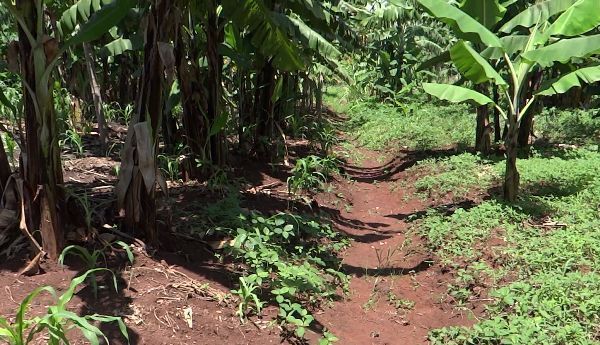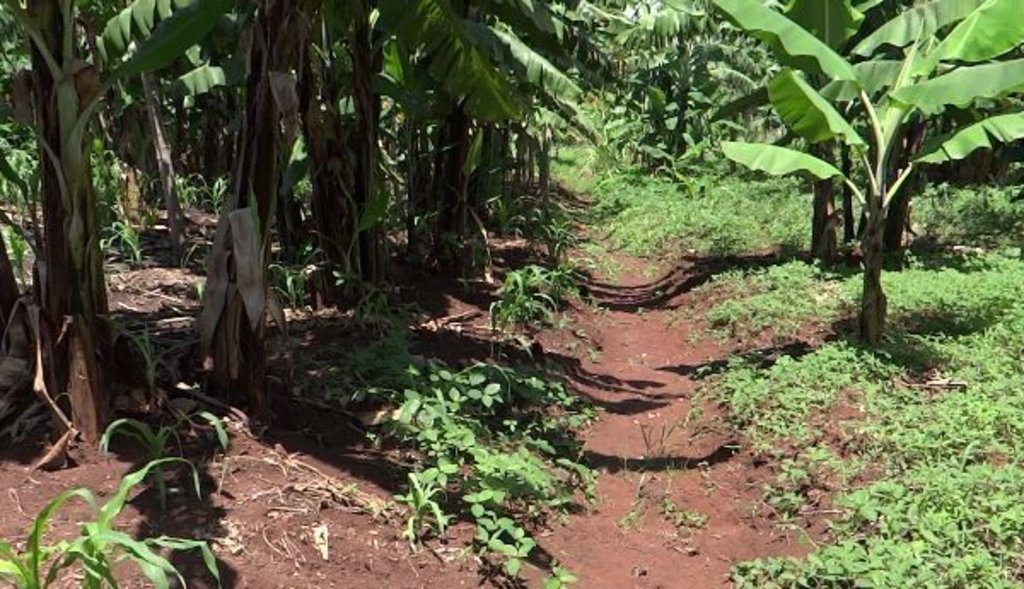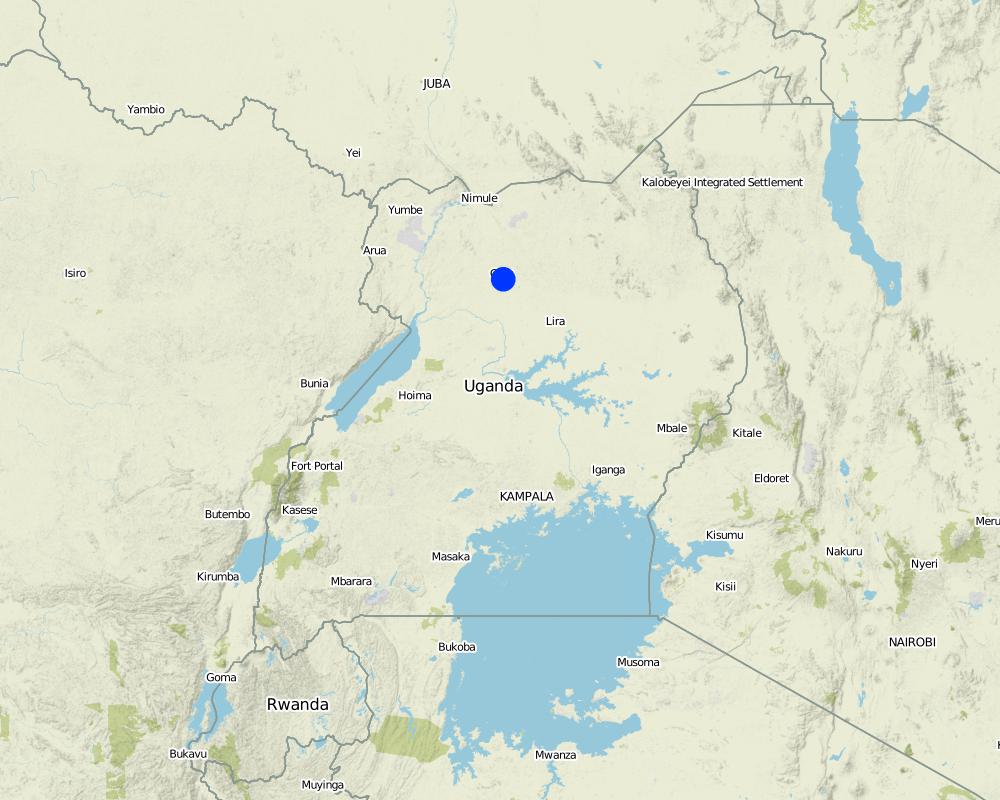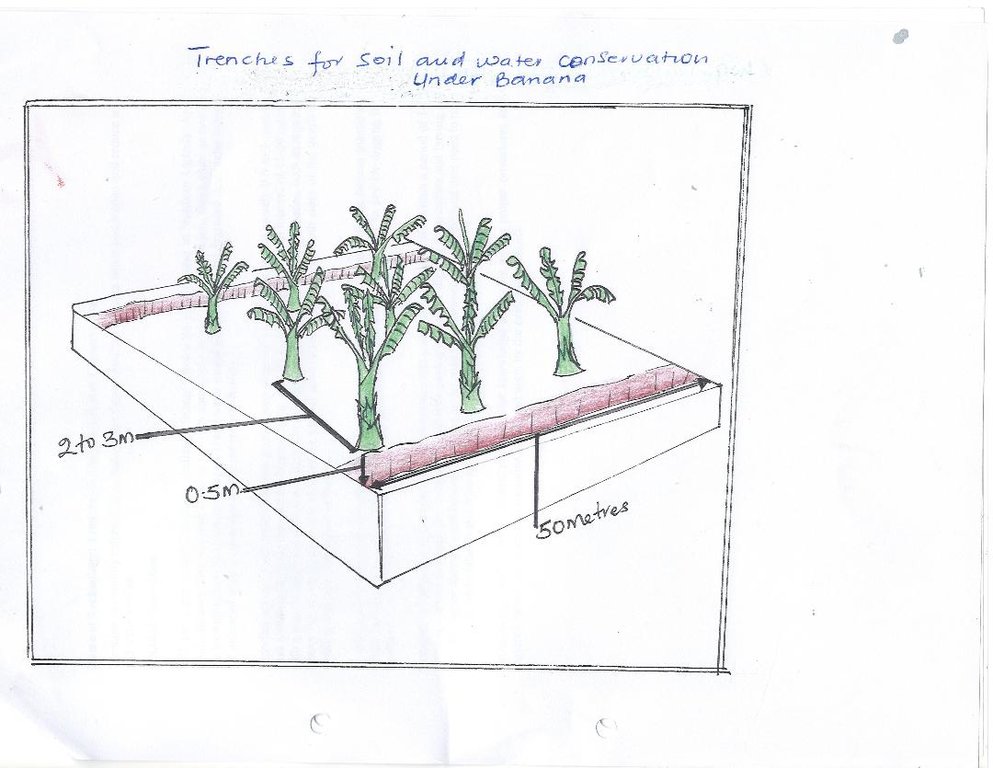Trenches for soil and water conservation under banana. [Uganda]
- Creation:
- Update:
- Compiler: Kamugisha Rick Nelson
- Editors: JOY TUKAHIRWA, Sunday Balla Amale, Bernard Fungo
- Reviewers: John Stephen Tenywa, Nicole Harari, Renate Fleiner, Stephanie Jaquet, Donia Mühlematter
Baro kor pii
technologies_2274 - Uganda
View sections
Expand all Collapse all1. General information
1.2 Contact details of resource persons and institutions involved in the assessment and documentation of the Technology
Key resource person(s)
land user:
Acen Kaven
Gulu District
Uganda
Name of project which facilitated the documentation/ evaluation of the Technology (if relevant)
Scaling-up SLM practices by smallholder farmers (IFAD)Name of the institution(s) which facilitated the documentation/ evaluation of the Technology (if relevant)
CDE Centre for Development and Environment (CDE Centre for Development and Environment) - Switzerland1.3 Conditions regarding the use of data documented through WOCAT
When were the data compiled (in the field)?
10/05/2017
The compiler and key resource person(s) accept the conditions regarding the use of data documented through WOCAT:
Ja
1.4 Declaration on sustainability of the described Technology
Is the Technology described here problematic with regard to land degradation, so that it cannot be declared a sustainable land management technology?
Nee
Comments:
The technology is useful in controlling soil and water runoffs under banana.
2. Description of the SLM Technology
2.1 Short description of the Technology
Definition of the Technology:
Trenches commonly referred to as “fanny juu, fanya chini” increase water infiltration and reduce soil erosion.
2.2 Detailed description of the Technology
Description:
Soil and water runoff is a major challenge encountered by farmers growing banana in Northern Uganda. As a remedy, farmers have started using trenches commonly referred to fanya juu, fanya chini. This is one of the technologies intended to help reduce soil and water runoff on cultivated and degraded land under banana in order to increase water infiltration and improve soil fertility.
The trenches are normally established during the dry season on small pieces of land of about 0.5 to 1 acre, with slopes ranging from 16 to 30% in areas with high rainfall. The trenches are measured, using a tape measure, 0.5 m deep and 50 m long banana planted at a spacing of 3 metres between plants to allow suckers to grow in addition to applying cow dung during maintenance which is locally obtained at no cost.
Implements and materials required to construct the trenches include ropes, spades, and hoes. Once the trenches have been constructed, natural grass can be allowed to grow or elephant grass planted on both sides of the trenches to stabilize the soils and reduce sediments falling into the trenches.
In this practice, the land user starts with identifying soil erosion hotspots within the banana plantation where the trenches are to be established. This is followed by looking for labour and money to pay for digging the trenches.
Trenches are effective in reducing soil and water runoffs under banana production immediately when it starts raining. It is worth to note that, the costs associated with paying labour for digging the trenches and buying inputs are higher during establishment compared to the costs of maintenance; this is because during maintenance the land user only needs to pay for labour to remove sediments from the trenches.
Establishing trenches under banana plantations requires the land user to be provided with prior knowledge and skills through training on the proper procedures on establishing the trench using the correct measurements of 0.5 m deep and 50 m long with banana planted at a spacing of 3 metres with the help of a tape measure, ropes, spades, and hoes and as required inputs.
2.3 Photos of the Technology
2.4 Videos of the Technology
Comments, short description:
Video on trenches for soil and water conservation
Date:
26/05/2017
Location:
Gulu District, Northern Uganda
Name of videographer:
Issa Aiga
2.5 Country/ region/ locations where the Technology has been applied and which are covered by this assessment
Country:
Uganda
Region/ State/ Province:
Northern Region,Uganda
Further specification of location:
Gulu District
Map
×2.6 Date of implementation
Indicate year of implementation:
2015
If precise year is not known, indicate approximate date:
- less than 10 years ago (recently)
2.7 Introduction of the Technology
Specify how the Technology was introduced:
- through land users' innovation
Comments (type of project, etc.):
The land user started on his own after participating in a field visit in South Western Uganda and later supported by the extension agent through training.
3. Classification of the SLM Technology
3.1 Main purpose(s) of the Technology
- improve production
- reduce, prevent, restore land degradation
- reduce risk of disasters
- create beneficial economic impact
3.2 Current land use type(s) where the Technology is applied

Cropland
- Annual cropping
Main crops (cash and food crops):
Banana

Other
Specify:
Trenches
3.3 Further information about land use
Water supply for the land on which the Technology is applied:
- rainfed
Number of growing seasons per year:
- 2
Livestock density (if relevant):
2 cows
3.4 SLM group to which the Technology belongs
- integrated soil fertility management
- improved plant varieties/ animal breeds
- water harvesting
3.5 Spread of the Technology
Specify the spread of the Technology:
- evenly spread over an area
If the Technology is evenly spread over an area, indicate approximate area covered:
- < 0.1 km2 (10 ha)
3.6 SLM measures comprising the Technology

agronomic measures
- A1: Vegetation/ soil cover
- A2: Organic matter/ soil fertility
- A5: Seed management, improved varieties

vegetative measures
- V2: Grasses and perennial herbaceous plants

structural measures
- S1: Terraces
- S7: Water harvesting/ supply/ irrigation equipment

management measures
- M1: Change of land use type
- M2: Change of management/ intensity level
3.7 Main types of land degradation addressed by the Technology

soil erosion by water
- Wt: loss of topsoil/ surface erosion
- Wg: gully erosion/ gullying
- Wo: offsite degradation effects

physical soil deterioration
- Pw: waterlogging

biological degradation
- Bc: reduction of vegetation cover

water degradation
- Hw: reduction of the buffering capacity of wetland areas
3.8 Prevention, reduction, or restoration of land degradation
Specify the goal of the Technology with regard to land degradation:
- prevent land degradation
- restore/ rehabilitate severely degraded land
Comments:
Trenches reduces the speed of water which when not controlled washes away the soil nutrients.
Desilitation restores fertility removed from the trench and taken back to the banana garden.
4. Technical specifications, implementation activities, inputs, and costs
4.1 Technical drawing of the Technology
4.2 Technical specifications/ explanations of technical drawing
Trenches are normally established during the dry season on small pieces of land of about 0.5 to 1 acre, with slopes ranging from 16 to 30 % in areas with high rainfall. The trenches are measured using a tape measure, 0.5 m deep and 50 m long banana planted at a spacing of 3 metres between plants to allow suckers grow.
4.3 General information regarding the calculation of inputs and costs
Specify how costs and inputs were calculated:
- per Technology area
Indicate size and area unit:
0.5 to 1 acre
other/ national currency (specify):
UGX
Indicate exchange rate from USD to local currency (if relevant): 1 USD =:
3350.0
Indicate average wage cost of hired labour per day:
5000
4.4 Establishment activities
| Activity | Type of measure | Timing | |
|---|---|---|---|
| 1. | Identify erosion hot spot area | Other measures | During the dry season/ after heavy rains |
| 2. | Look for the tools and labour | Other measures | During the dry season |
| 3. | Measure the size of trench | Structural | During the dry season/ before rains set |
| 4. | Dig the trench | Other measures | During the dry season/ before rains set |
| 5. | Desilt when it fillsup with soil | Management | During the dry season/ after rains |
4.5 Costs and inputs needed for establishment
| Specify input | Unit | Quantity | Costs per Unit | Total costs per input | % of costs borne by land users | |
|---|---|---|---|---|---|---|
| Labour | Persons days | persons | 10.0 | 5000.0 | 50000.0 | 100.0 |
| Equipment | Spade | Pieces | 10000.0 | 100.0 | ||
| Equipment | Wheel barrow | Pieces | 10000.0 | 100.0 | ||
| Equipment | Ropes | Pieces | 1.0 | 3000.0 | 3000.0 | 100.0 |
| Equipment | Tape measure | pieces | 1.0 | 25000.0 | 25000.0 | |
| Total costs for establishment of the Technology | 78000.0 | |||||
Comments:
Planting material (natural grass or elephant grass planted on the trenches is obtained free and no costs involved on purchase of planting material.
Total costs for establishing trenches are much higher at the time of establishment compared to the costs of maintenance and the benefits are high both in the short and long term.
4.6 Maintenance/ recurrent activities
| Activity | Type of measure | Timing/ frequency | |
|---|---|---|---|
| 1. | Desiliting | Management | At least every year after heavy rains/ during dry season |
Comments:
The farmer uses cow dung to maintain the technology which is locally obtained at no cost.
4.7 Costs and inputs needed for maintenance/ recurrent activities (per year)
| Specify input | Unit | Quantity | Costs per Unit | Total costs per input | % of costs borne by land users | |
|---|---|---|---|---|---|---|
| Labour | Labour | Persons | 5.0 | 5000.0 | 25000.0 | 100.0 |
| Fertilizers and biocides | Fertiliser | Kgs | 2.0 | 3500.0 | 7000.0 | 100.0 |
| Fertilizers and biocides | Biocides | litres | 2.0 | 3500.0 | 7000.0 | 100.0 |
| Total costs for maintenance of the Technology | 39000.0 | |||||
4.8 Most important factors affecting the costs
Describe the most determinate factors affecting the costs:
Labour for digging trenches, desilting and re-applying the silt in the garden.
5. Natural and human environment
5.1 Climate
Annual rainfall
- < 250 mm
- 251-500 mm
- 501-750 mm
- 751-1,000 mm
- 1,001-1,500 mm
- 1,501-2,000 mm
- 2,001-3,000 mm
- 3,001-4,000 mm
- > 4,000 mm
Specify average annual rainfall (if known), in mm:
1350.00
Specifications/ comments on rainfall:
Two rainy season March -May and September to November.
Agro-climatic zone
- humid
5.2 Topography
Slopes on average:
- flat (0-2%)
- gentle (3-5%)
- moderate (6-10%)
- rolling (11-15%)
- hilly (16-30%)
- steep (31-60%)
- very steep (>60%)
Landforms:
- plateau/plains
- ridges
- mountain slopes
- hill slopes
- footslopes
- valley floors
Altitudinal zone:
- 0-100 m a.s.l.
- 101-500 m a.s.l.
- 501-1,000 m a.s.l.
- 1,001-1,500 m a.s.l.
- 1,501-2,000 m a.s.l.
- 2,001-2,500 m a.s.l.
- 2,501-3,000 m a.s.l.
- 3,001-4,000 m a.s.l.
- > 4,000 m a.s.l.
Indicate if the Technology is specifically applied in:
- concave situations
5.3 Soils
Soil depth on average:
- very shallow (0-20 cm)
- shallow (21-50 cm)
- moderately deep (51-80 cm)
- deep (81-120 cm)
- very deep (> 120 cm)
Soil texture (topsoil):
- coarse/ light (sandy)
Soil texture (> 20 cm below surface):
- medium (loamy, silty)
Topsoil organic matter:
- medium (1-3%)
5.4 Water availability and quality
Ground water table:
5-50 m
Availability of surface water:
poor/ none
Water quality (untreated):
poor drinking water (treatment required)
Is water salinity a problem?
Nee
Is flooding of the area occurring?
Nee
5.5 Biodiversity
Species diversity:
- medium
Habitat diversity:
- medium
5.6 Characteristics of land users applying the Technology
Sedentary or nomadic:
- Sedentary
Market orientation of production system:
- subsistence (self-supply)
- mixed (subsistence/ commercial
Off-farm income:
- less than 10% of all income
Relative level of wealth:
- poor
Individuals or groups:
- individual/ household
- groups/ community
Level of mechanization:
- manual work
Gender:
- men
Age of land users:
- youth
- middle-aged
Indicate other relevant characteristics of the land users:
Trench making is a technology that is more labour intensive and is usually not appropriate for women to do.
5.7 Average area of land owned or leased by land users applying the Technology
- < 0.5 ha
- 0.5-1 ha
- 1-2 ha
- 2-5 ha
- 5-15 ha
- 15-50 ha
- 50-100 ha
- 100-500 ha
- 500-1,000 ha
- 1,000-10,000 ha
- > 10,000 ha
Is this considered small-, medium- or large-scale (referring to local context)?
- small-scale
5.8 Land ownership, land use rights, and water use rights
Land ownership:
- group
- individual, not titled
Land use rights:
- open access (unorganized)
Water use rights:
- open access (unorganized)
5.9 Access to services and infrastructure
health:
- poor
- moderate
- good
education:
- poor
- moderate
- good
technical assistance:
- poor
- moderate
- good
employment (e.g. off-farm):
- poor
- moderate
- good
markets:
- poor
- moderate
- good
energy:
- poor
- moderate
- good
roads and transport:
- poor
- moderate
- good
drinking water and sanitation:
- poor
- moderate
- good
financial services:
- poor
- moderate
- good
6. Impacts and concluding statements
6.1 On-site impacts the Technology has shown
Socio-economic impacts
Production
crop production
land management
Income and costs
expenses on agricultural inputs
Comments/ specify:
High at the time digging trenches but over a period of time reduces
farm income
Comments/ specify:
From the sale of banana.
workload
Comments/ specify:
More tasks at establishment and over a period of time reduces which affects labour costs.
Socio-cultural impacts
food security/ self-sufficiency
SLM/ land degradation knowledge
Comments/ specify:
Extension workers extend knowledge to the farmers and other farmers come to learn from other farmers promoting the technology.
Ecological impacts
Soil
soil cover
Comments/ specify:
As a planted grasses (elephant grass) on the trench.
soil loss
Comments/ specify:
Due to the presence of the trenches and grasses planted as stabilizers.
Climate and disaster risk reduction
landslides/ debris flows
6.2 Off-site impacts the Technology has shown
water availability
Comments/ specify:
Water runoff is controlled by the trench.
6.3 Exposure and sensitivity of the Technology to gradual climate change and climate-related extremes/ disasters (as perceived by land users)
Gradual climate change
Gradual climate change
| Season | Type of climatic change/ extreme | How does the Technology cope with it? | |
|---|---|---|---|
| annual temperature | increase | moderately | |
| seasonal temperature | wet/ rainy season | decrease | moderately |
Climate-related extremes (disasters)
Climatological disasters
| How does the Technology cope with it? | |
|---|---|
| drought | moderately |
Hydrological disasters
| How does the Technology cope with it? | |
|---|---|
| landslide | moderately |
6.4 Cost-benefit analysis
How do the benefits compare with the establishment costs (from land users’ perspective)?
Short-term returns:
slightly positive
Long-term returns:
very positive
How do the benefits compare with the maintenance/ recurrent costs (from land users' perspective)?
Short-term returns:
slightly positive
Long-term returns:
very positive
Comments:
More costs for labour and inputs for digging trenches at estsblishment than costs required for maintaing and desilting.
6.5 Adoption of the Technology
- 1-10%
If available, quantify (no. of households and/ or area covered):
Those who have adopted are those that are outiside the group as a resulting of copying from the group.
Of all those who have adopted the Technology, how many have did so spontaneously, i.e. without receiving any material incentives/ payments?
- 10-50%
Comments:
Around 40%.
6.6 Adaptation
Has the Technology been modified recently to adapt to changing conditions?
Ja
If yes, indicate to which changing conditions it was adapted:
- climatic change/ extremes
Specify adaptation of the Technology (design, material/ species, etc.):
By planting natural and elephant grass to reduce soil and water run off.
6.7 Strengths/ advantages/ opportunities of the Technology
| Strengths/ advantages/ opportunities in the land user’s view |
|---|
| Good at reducing soil and water runoff. |
| The costs of maintaining trenches in a banana plantation are rather low compared to the costs of estsblishment. Costs may be only high when it comes to weeding the banana. |
| Strengths/ advantages/ opportunities in the compiler’s or other key resource person’s view |
|---|
| Trenches are effective in controlling soil erosion. |
6.8 Weaknesses/ disadvantages/ risks of the Technology and ways of overcoming them
| Weaknesses/ disadvantages/ risks in the land user’s view | How can they be overcome? |
|---|---|
| Labour intensive with high costs at estsblishment than maintenance. | Work in groups. |
| Requires knowledge and skills which a farmer may not have at the time of establishment. |
Consult extension agents to provide technical guidance. Provide trainings on proper procedures for estsblishment. |
| Weaknesses/ disadvantages/ risks in the compiler’s or other key resource person’s view | How can they be overcome? |
|---|---|
| Trenches alone may not be a measure for reducing land degradation. | Plant agrofrestry trees (Callindra , Grivellea, and Elephant grass where trenches are established. Fodder). |
7. References and links
7.1 Methods/ sources of information
- field visits, field surveys
01
- interviews with land users
01
Links and modules
Expand all Collapse allLinks
No links
Modules
No modules





